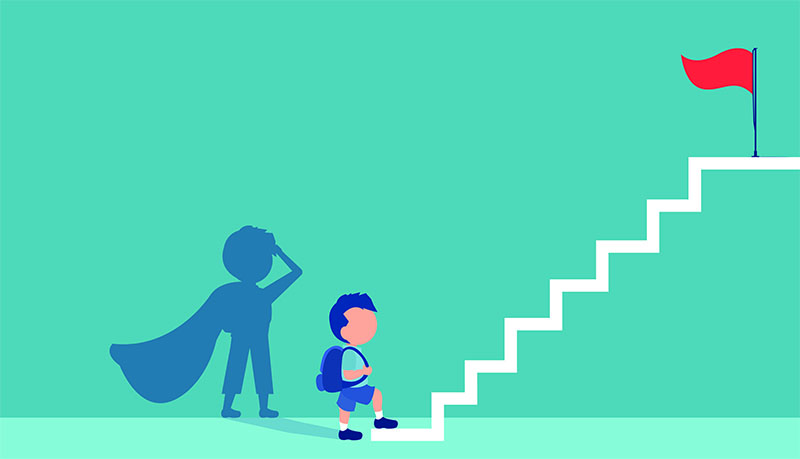
Goals are important for a healthy life. Whether the goal is to have an interesting career or to make a lot of money or to help others, these are all goals that people have because it makes them happy, it gives them a purpose in life and it fits their personality. Kids need goals too. In fact, they need goals from a very young age. From the time that children have the ability to imitate their parents, they prove to us that they want to learn everything there is to know in order to participate in the family’s daily life. My grandkids help their mother in daily chores, such as stack the dishwasher, load the washing machine with clothes, and take care of their dolls the way their mom takes care of them. We tend to interpret this as child play rather than as an important step in establishing the roles that our children will assume in their daily life. As children get closer to school age, their education creates a disconnect between what they learn in school and the natural path of continuing to develop the role they are supposed to play in the future.
Prehistoric societies have already shown that the natural goal of children’s education was to step with confidence into their roles in life. As early as the children could be taught, parents were training the young generation in daily survival skills. The entire goal of their education was to ensure that the younger generation could confidently perform the chores necessary for daily survival. Daily repetition of those chores led the children to an adult-level proficiency necessary to become equal contributors to their family’s survival and a stepping stone for later establishing their own families.
This natural orientation towards developing life skills was abruptly discontinued during the industrial revolution, when organizations were built for mass production, assembly line work, and factory jobs. To address these needs, young workers were trained to value hierarchical commands, standardized outcomes, and specialized skills, forming the basis for school bureaucracies today.
In this education method that our schools are following to this date, the focus on core subjects, disconnected from meaningful context, are leaving students clueless as to the purpose they serve, but mainly how they tie into their daily life. Wondering why they need to learn certain things is a daily routine, leaving students clueless as to the direction that they will be taking in life or that they need to have a goal at all. By the time they finish high school, most students have no idea what they will be doing in life or what type of profession to pursue. This is also the reason why so many students spend many years in college trying to figure out what interests them and many times ending up with a profession that they later discover is not what they expected.
Young people whose upbringing exposed them to a variety of daily life routines are able to accumulate basic knowledge that can help them make an educated decision as to the direction that they want to pursue in life. When students lack this type of exposure, their ability to understand what awaits them in real life is based on a series of core subjects introduced to them, without any context or relationship to real life, in school. Students with exposure feel in control of their life and are able to direct their next steps towards a clear goal, while the latter are in a constant state of indecisiveness and lack of confidence in their ability to take control of their lives. This lack of confidence and direction can also lead to mental health issues because students feel disconnected from a clear path that can prepare them to assume their roles in real life.
An education system that tries to tailor learning towards providing students with the skills they will need for real life is in Finland. In his book “Finish Lessons 3.0: What Can the World Learn From Educational Change in Finland,” Pasi Sahlberg writes that the central mechanism of their education system is the “Individual Education Plan that every child must have. It is prepared in kindergarten in collaboration with parents or guardians and children. … typically identifies the child’s areas of interests and strengths together with possible special educational needs. It also includes pedagogical guidelines for meeting the goals included in the plan …. The aim … is to engage parents more closely … and also to make children more aware of goals and responsibilities regarding their own education.”
As mentioned above, this process starts early before the student joins school in kindergarten, building on young kids’ inclination to imitate the adult world through play. In “Finland…people take play very seriously. …free outdoor play during early childhood benefits children more than anything else. Most teachers agree that teaching and learning in primary school should be built on children’s active engagement in playful activities rather than teaching different subjects in more traditional ways. Many secondary schools incorporate learning through play in their menus of teaching methods to engage students more in experimentation, exploration, and discovery across the curriculum (Sahlberg, 2021).” Even in high school the focus on advancing the fulfillment of the student’s identified goals continues in Finland, by allowing them to “build their own personalized learning schedules from a menu of courses offered in their school or by other education institutions (Sahlberg, 2021).”
This method guarantees that students keep their focus on their identified goals and are able to confidently step into real life. Taking the student’s interests and strengths into account at a young age and translating them into pedagogical goals should be a starting point for every educational institution planning the educational path that their students will pursue. This can lead to students graduating with a clear view of what their future will look like and the steps they will be taking as adults to fulfill them.
